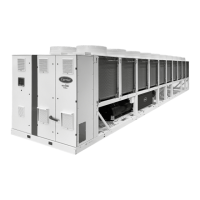10.6 - Flooded Evaporator maintenance
Check that:
■ The insulating foam is neither detached nor torn during works,
■ The heaters and probes are operating and correctly positioned
in their supports,
■ The water-side connections are clean and show no sign of
leakage.
10.7 - Screw Compressor maintenance
10.7.1 - Checking the compressor rotation
Ensuring the compressor rotation is correct is one of the most
critical considerations.
Reverse rotation, even for a short period, will have a considerable
adverse eect on the compressor's reliability, and may even cause
irreparable damage. The reverse rotation protection process must
be capable of determining the direction of rotation and stopping
the compressor within one second.
Reverse rotation is most likely to occur whenever the wiring at the
compressor terminals has been modied.
To minimise any risk of reverse rotation, the following procedure
must be applied.
Rewire the electrical wires to the compressor terminals as originally
wired. Keep a counter torque on the lower nut on the power supply
cable terminal lug when the latter is installed.
When a compressor is replaced, a low pressure switch must be
installed temporarily as a safety measure on the high pressure
part of the compressor. The purpose of this pressure switch is to
protect the compressor against any wiring errors at the compressor
terminals.
The electrical contact of the switch would be wired in series with
the high pressure switch.
The pressure switch must remain in place until the compressor
has been started and direction of rotation has been veried;
at this point, the pressure switch can be removed.
The switch that has been selected for detecting reverse rotation
is Carrier part number HK01CB001. This pressure switch opens
the contacts when the pressure falls below 7 kPa. The pressure
switch has a manual reset, which can be reset when the pressure
exceeds 70 kPa once more. The pressure switch must be a manual
reset type to prevent any risk of the compressor short cycling in
the reverse direction.
10.7.2 - Oil separator
Check that the heaters are operating correctly and that they are
rmly attached to the oil separator.
10.7.3 - Oil lter change schedule
As keeping the system clean is critical to ensure its reliable
operation, there is a lter in the oil pipe at the oil separator outlet.
The oil lter is specied to provide a high level of ltration (5 µ),
necessary for ensuring the compressor has a long service life.
The lter should be checked after the rst 500 hours of operation,
and every subsequent 2000 hours. The lter must replaced as
soon as the pressure dierential on the lter exceeds 200 kPa
(2 bar).
The pressure drop on the lter is determined by measuring the
pressure at the discharge (dp) and the oil pressure (op).
The dierence in these two pressures will be the pressure drop
on the lter, check valve, and solenoid valve.
The pressure drop on the check valve and solenoid valve is
approximately 40 kPa (0.4 bar), which should be subtracted from
the two oil pressure measurements to give the oil lter pressure
drop.
10.7.4 - Periodic test of the high pressure safety
loop
The aim of this periodic test is to check the settings of the high
pressure safety loop on one of the unit's refrigerant circuits and
check it is operating correctly. This procedure must be repeated
for each circuit.
1. Fit a calibrated pressure gauge on the high pressure part of
the circuit (compressor discharge)
2. Reset all the active alarms
3. Activate the HP test mode for the corresponding circuit via the
control interface.
The high pressure test maybe dened in the fan addressing
menu (FAN DRV2).
To activate the high pressure test for a specic circuit, access
the Maintenance menu.
Select Fan addressing (section 5.5.10).
Set the high pressure test A or high pressure test B to "yes".
4. Save the fault trip value
5. Check that the two HPS have tripped
If the two HPS have tripped, move on to step 9
If just one of the HPS has tripped,
6. Replace the tripped HPS with another system which has a
greater value.
Alternatively, an emergency stop button can be installed.
7. Repeat steps 2 to 5
8. Check whether the trip values are correct
The trip values must be between +0/-1.4 bars of the rated value
indicated on the unit.
9. Reset all the alarms
10. Reset both the HPS
11. Deactivate the HP test mode for the circuit
NOTE: For step 6, electrical diconnection of the tripped HPS
and its substitution must be performed within the electrical
box that encloses the control an regulation components.
Identify the HPS connectors with the detailed electrical
diagram.
The connector type must be WAGO 231-302 or equivalent.
10 - SYSTEM STANDARD MAINTENANCE
59

